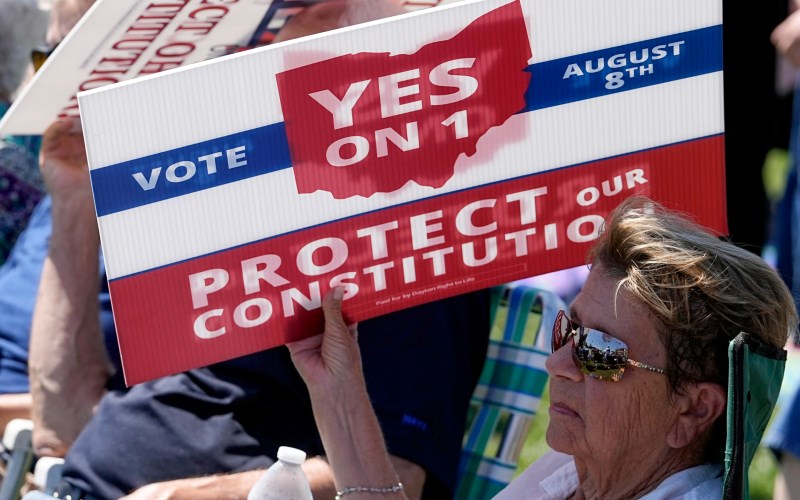The Issue 1 proposal, which was handily defeated on the ballot, would have made it more difficult for voters to amend the state constitution. A "Yes" vote would have enacted the measure immediately and nullified an abortion rights amendment that got on the November ballot with almost 500,000 valid petition signatures.
Existing law allows for changes to the state constitution with only a simple majority but Issue 1 would have raised the threshold to 60% of votes cast.
Issue 1 loss: Outspent and outvoted, but not defeatedAmerican Family News staff After a lopsided loss to abortion supporters over Issue 1, which sets up an abortion amendment in November, pro-life activists are vowing to keep fighting while learning a lesson from the stinging loss. “The fight is far from over and we're just getting started,” says Ohio Right to Life spokesperson Elizabeth Marbach after the 70%-30% defeat on Issue 1. “That is where all of our focus is going to go, all the way until the November election,” she continues, “in defeating the abortion lobby so that state-sanctioned murder is not enshrined into our constitution.” Mark Harrington of Created Equal tells AFN it is obvious the pro-abortion side turned out to vote Tuesday. “And the other side clearly beat us when it comes to early voting,” he acknowledges. “So we have our work cut out for us.” Columbus resident Linda Harvey, who leads Mission: America, tells AFN she encountered numerous conservative voters who voted “no” and misunderstood what Issue 1 was attempting to do. “Our side did not spend enough time explaining the issue for people that are only marginally engaged,” she says. “And I know the mainstream media didn't do us any favors because they were overwhelmingly touting the ‘no’ vote." In another AFN interview, Janet Porter of Faith2Action calls the outcome "discouraging" but says it is time to work toward November. Churches must stand up, she adds, beginning with pastors who are unafraid to condemn baby killing. "Our hidden secret is the pastors," she says. |
Ohio law currently allows abortion until the point that a fetus can survive outside the womb, which is generally accepted as 22 weeks.
Gov. Mike DeWine in 2019 signed the state’s “Heartbeat Bill” which bans abortion at six weeks. The law did not take effect as a judge issued an injunction in response to a lawsuit filed by The American Civil Liberties Union and others.
Another judge allowed the law to move forward after the Supreme Court gave states the ability to regulate abortion last June, but last September a third judge blocked the law again in response to a lawsuit filed by Ohio abortion clinics.
Show me the far-left money trail
Abortion activists from outside of Ohio poured millions into the effort to defeat Issue 1.
According to The Ohio Press Network, $14.8 million was raised by opponents of Issue 1 with $12 million coming from beyond state borders.
Arabella Advisors, a Washington, D.C.-based group which stresses Diversity, Equity and Inclusion while helping “changemakers realize their visions,” spent $3.5 million in the measure.
Arabella funds took in $1.6 billion in 2021.
Two-thirds of Arabella’s Issue 1 money came from The Sixteen Thirty Fund, a group active in opposing Brett Kavanaugh’s Supreme Court nomination which has ties to Swiss billionaire Hansjorg Wyss. Wyss was a significant source of funding for Joe Biden in 2020.
The Sixteen Thirty Fund prioritizes economic equity, climate solutions, racial justice and “other essential social-change goals.”
Issue 1 supporters had far less outside money. The Statehouse News Bureau reported proponents took in $4.8 million, $4 million of it from Illinois businessman Richard Uihlein, a shipping container magnate.
Issue 1 opponents spent 70% of funds raised, much of it TV ads, to deliver its Tuesday win, Statehouse reported. Supporters of Issue 1 spent only about a third of their available funds.
The Columbus Dispatch, located in the state’s capital and largest city, predicts no easy path to victory for abortion activists in November.
“Tens of millions will be spent on both sides of this political battle,” The Dispatch wrote.
A USA Today poll in July showed 57.6% of Ohio voters support a state constitutional amendment that says, “Every individual has a right to make and carry out one’s own reproductive decisions, including but not limited to decisions on contraception, fertility treatment, continuing one’s own pregnancy, miscarriage care and abortion.”
Watch early voting in November
Early balloting could be a predictor of how the constitutional amendment might turn out in November.
More than 700,000 early votes were cast this round with 70% against Issue 1, The Associated Press reported.
Half of all voters who identified as Democrat voted before Election Day compared to 40% of voters who identify as Republican.
Some state legislatures have passed abortion bans or strict restrictions, but voters have responded differently since the Supreme Court’s decision in June of 2022 to return the abortion question to states.
Voters in Michigan, California and Vermont have approved initiatives designed to protect abortion access. Voters in Kentucky, Kansas and Montana have said no to greater abortion restrictions in their states.







